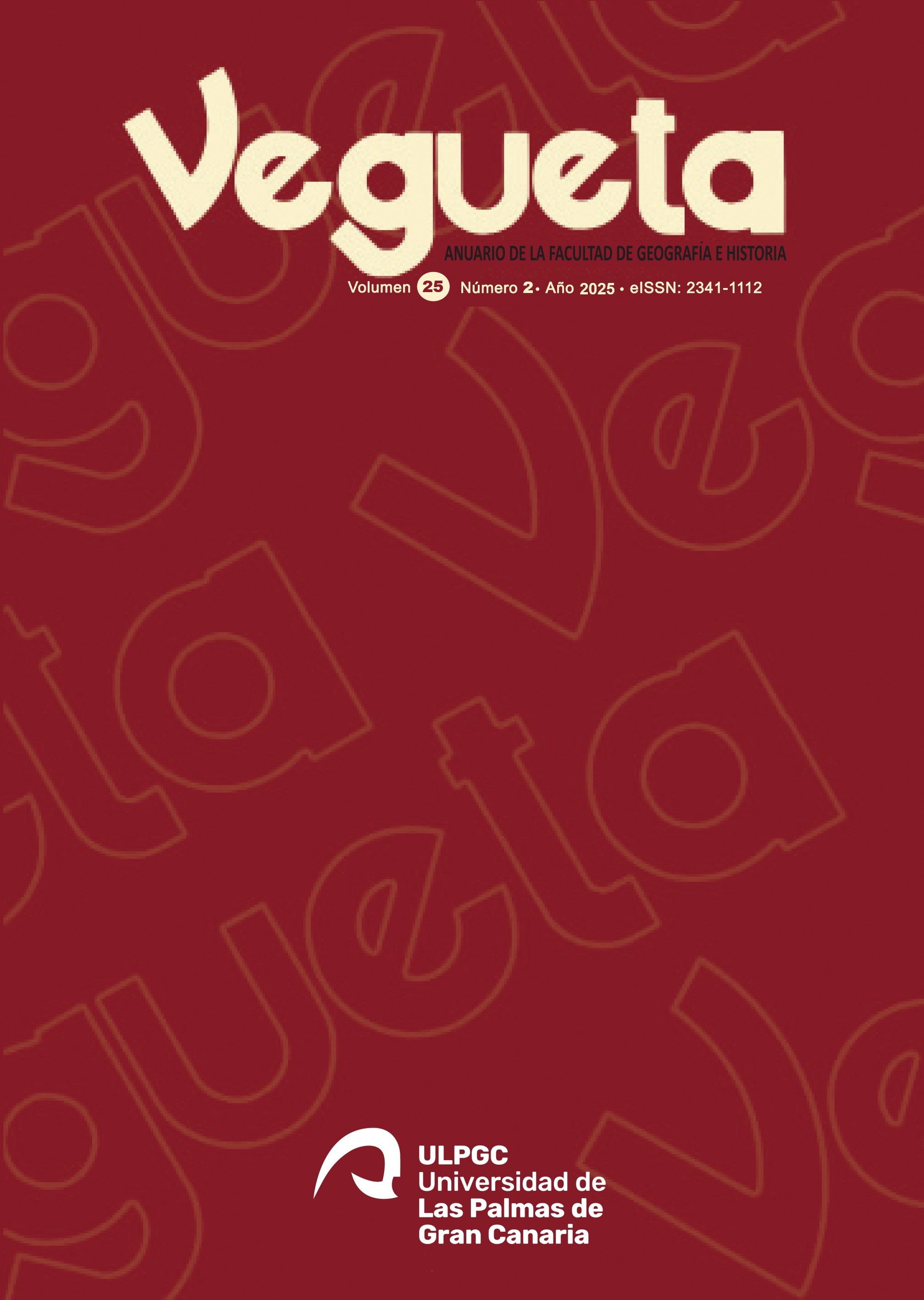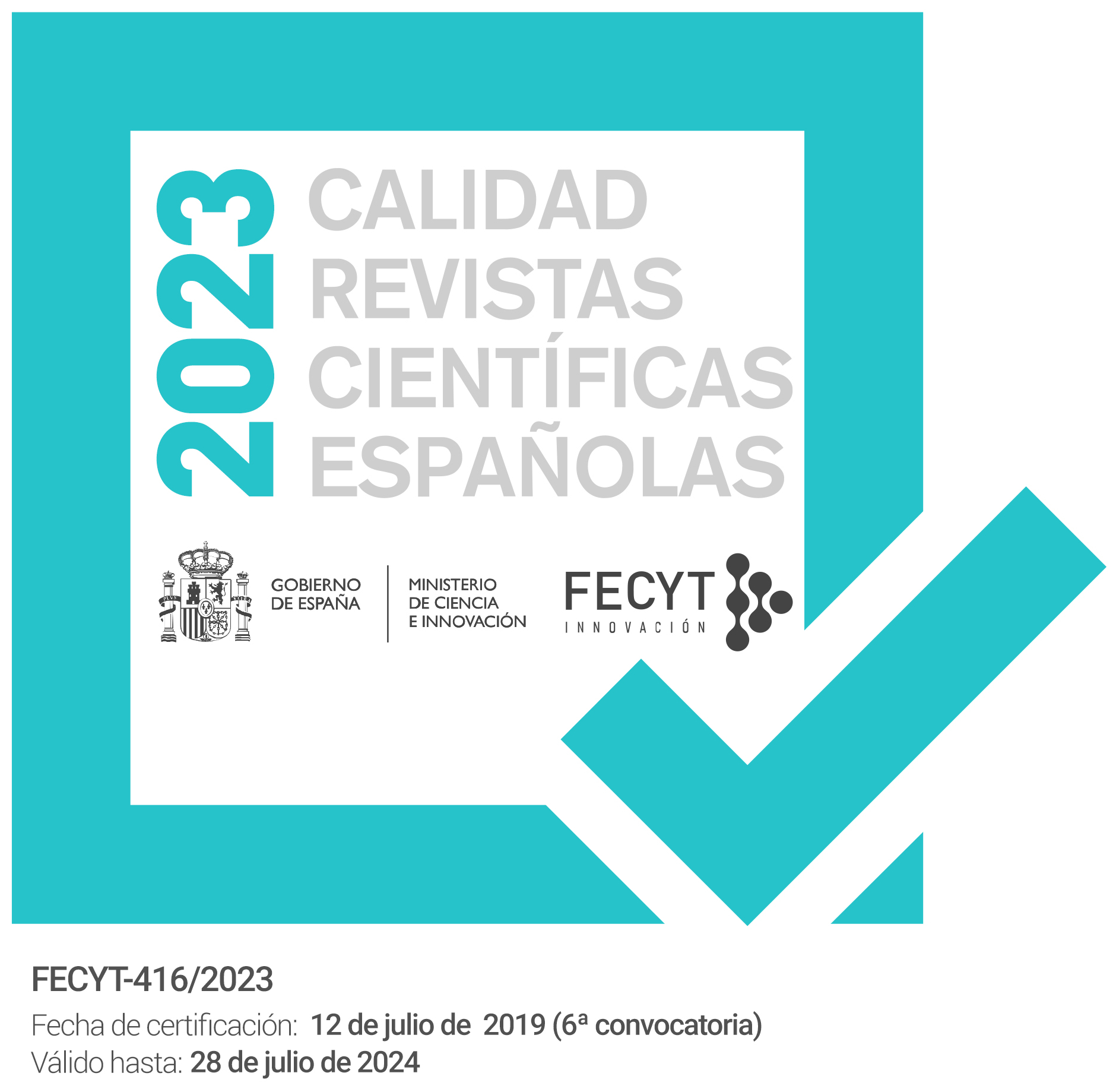The Spatial Turn for the Myronian Sculptural Group of Athena and Marsyas. Toward a parasemantic proposal
DOI:
https://doi.org/10.51349/veg.2025.2.19Keywords:
spatial turn, Memory studies, votive statues, Athens, MyronAbstract
The review of archaeological studies on the reconstruction of the Athenian Acropolis in the mid-5th century BC challenges the traditional discourse regarding the location and interpretation of the Myronian sculptural group of Athena and Marsyas (450-440 BC). Alongside the formal and iconographic analysis of the votive ensemble -anathema-, the incorporation of the spatial dimension provides a semantic alternative closely linked to recent Memory studies. Understanding the space surrounding the group and the dynamic interaction generated between it and the observer reveals a potential ethnic Athenian identity reading hidden behind the Myronian bronze.
Downloads
References
- Andrén, A. (1944): Der lateranische Silen und die Gruppe von Athena und Marsyas, Opuscula archaeologica, 3: 1-36.
- de Angelis, F. (1996): La battaglia di Maratona nella Stoa Poikile, ASNP, 4 (1): 119-171. https://www.jstor.org/stable/24308167
- Barker, A. (1984): Greek Musical Writings. I. The Musician and his Art, Cambridge University Press, Cambridge.
- Bellido-Pérez, E. (2021): La educación de la mirada: el mito de la Gigantomaquia en el arte como herramienta propagandística a lo largo de la historia, Educação & Linguagem, 24 (1): 289-304. doi: https://doi.org/10.15603/2176-1043/el.v24n1p289-304.
- Boardman, J. (1956): Some Attic Fragments: Pot, Plaque, and Dithyramb, The Journal of Hellenic Studies, 76: 18-25. doi: https://doi.org/10.2307/629550
- Caire, E. (2015): Jouer de l’aulos à Athènes était-il politiquement correct?, Pallas. Revue d’études antiques, 98: 57-72. doi: https://doi.org/10.4000/pallas.2650
- Castriota, D. (1992): Myth, Ethos, Actuality. Official Art in Fifth-Century B.C. Athens, The University of Wisconsin Press, Madison.
- Castriota, D. (2005): Feminizing the Barbarian and Barbarizing the Feminine. Amazons, Trojans and the Persians in the Stoa Poikile, en J. Barringer; J. Hurwit (eds.), Periklean Athens and Its Legacy. Problems and Perspectives, University of Texas Press, Austin: 89-102.
- Cerqueira, F. V. (2014): The presence of music in Greek worship. An iconographical approach, Chaos e Kosmos, 15: 1-40.
- Daltrop, G. (1980): Il gruppo mironiano di Atena e Marsia nei Musei Vaticani, Monumenti, Musei e Gallerie Pontifìcie, Ciudad del Vaticano.
- Daltrop, G.; Bol, P. C. (1983): Athena des Myron, Liebieghaus, Fráncfort del Meno.
- Davison, C. C. (2009): Pheidias. The Sculptures and Ancient Sources. Volume 1, University of London, Londres.
-Davison, J. A. (1958): Notes on the Panathenaea, The Journal of Hellenic Studies, 78: 23-42. doi: https://doi.org/10.2307/628920
- Domínguez, A. J.; Pascual, J. (1999): Esparta y Atenas en el siglo V a.C., Editorial Síntesis, Madrid.
- Elvira, M. A. (2019): Historia del arte griego. Obras y artistas de la antigua Grecia, Guillermo Escolar Editor, Madrid.
- Fehr, B. (2008): Bilderzählung und Handlungsmuster: Athena, Marsyas, der Aulos und die jungen Leute von Athen, en M. Seifert (ed.), Komplexe Bilder, Leonhard - Thurneysser-Verlag, Berlín - Basel; 129-149.
- la Follette, L. (1986): The Chalkotheke on the Athenian Akropolis, Hesperia, 55: 75-87. doi: https://doi.org/10.2307/147731
- Geominy, W. (2003): Athena und Marsyas – Eine frühklassische Gruppe in Raum und Zeit, en P. C. Bol (ed.), Zum Verhältnis von Raum und Zeit in der griechischen Kunst, Bibliopolis, Möhnesee: 143-160.
- von den Hoff, R. (2010): Theseus – Stadtgründer und Kulturheros, en E. Stein-Hölkeskamp; K. J. Hölkeskamp (eds.), Die griechische Welt. Erinnerungsorte der Antike, C. H. Beck., Múnich: 300-315.
- Hölscher, T. (1973): Griechische Historienbilder des 5. Und 4. Jahrhunderts v. Chr, Triltsch, Würzburg.
- Hölscher, T. (1998): Images and Political Identity: The Case of Athens, en D. Boedeker; K. Raaflaub, (eds.), Democracy, Empire, and the Arts in Fifth-Century Athens, Center for Hellenic Studies Colloquia, Cambridge: 153-183.
- Hölscher, T. (2015): Art, Architecture, and Spaces in Greek Participatory Communities, en D. Hammer (ed.), A Companion to Greek Democracy and the Roman Republic, Wiley-Blackwell, Oxford: 461-481.
- Hurwit, J. M. (1999): The Athenian Acropolis. History, Mythology, and Archaeology from the Neolithic Era to the Present, Cambridge University Press, Cambridge.
- Hurwit, J. M. (2004): The Acropolis in the age of Pericles, Cambridge University Press, Cambridge.
- Judeich, W. (1994) [1931]: Topographie von Athen, Ares Publishers, INC, Chicago.
- Junker, K. (2002): Die Athena-Marsyas-Gruppe des Myron, Jahrbuch des Deutschen Archaologischen Instituts, 117: 127-184.
- van Keer, E. (2004): The Myth of Marsyas in Ancient Greek Art: musical and mythological iconography, Music in Art, 29 (1-2): 20-37. https://ssrn.com/abstract=2263830
- Keesling, C. M. (2003): The votive statues of the Athenian Acropolis, Cambridge University Press, Cambridge.
- Keesling, C. M. (2020): Innovation and Deception: Athenian Commemoration of the Persian Wars, en M. Meyer; G. Adornato (eds.), Innovations and Inventions in Athens c. 530 to 470 BCE – Two Crucial Generations, Phoibos Verlag, Viena: 211-227.
- Kemp, J. A. (1966): Professional musicians in ancient Greece, Greece & Rome, 13 (2): 213-222. http://www.jstor.org/stable/642604
- Ludwig Preller, C. R. (1872): Griechische Mythologie, Weidmannsche Buchhandlung, Berlín.
- Meiggs, R. (1972): The Athenian Empire, Clarendon Press, Oxford.
- Moltesen, M. (1971): A new Replica of Myron's Athena, Analecta Romana. Instituto Danici, 6: 7-15.
- Müller, K. O. (1830): Handbuch der Archäologie der Kunst, Josef Max, Breslau.
-Newby, Z. (2016): Greek Myths in Roman Art and Culture. Imagery, Values and Identity in Italy, 50 BC–AD 250, Cambridge University Press, Cambridge.
- Nordquist, G. C. (1992): Instrumental Music in Representations of Greek Cult, en R. Hägg (ed.), The Iconography of Greek Cult in the Archaic and Classical Periods, Centre d’Étude de la Religion Grecque Antique, Atenas - Lieja: 143-168.
- van Oeveren, C. D. P. (1999): Bacchylides Ode 17: Theseus and the Delian League, en I. L. Pfeijffer; S. - R. Slings (eds.), One Hundred Years of Bacchylides, Proceedings of a Colloquim Held at the Vrije Universeieit Amsterdam, VU University Press, Amsterdam: 31-42.
- Pascual, J. (2001): Identidades y fronteras en Grecia central, en P. López; S. Reboreda (eds.), Fronteras e identidad en el mundo griego antiguo, Universidad de Santiago de Compostela - Universidad de Vigo, Santiago de Compostela - Vigo: 241-263.
- Picard, C. (1939): Manuel d'archéologie grecque: la sculpture, Tome 2, Vol. 1, Période Classique, Vè siècle, Auguste Picard, París.
- Pickard-Cambridge, A. (1968): The Dramatic Festivals of Athens, Clarendon Press, Oxford.
- Poehlmann, E. (2017): Aristotle on Music and Theatre (Politics VIII 6. 1340 b 20-1342b 34; Poetics), en A. Fountoulakis; A. Markantonatos; G. Vasilaros (eds.), Theatre World, Walter de Gruyter GmbH, Berlín - Boston: 317-345.
- Pollak, L. (1909): Die Athena der Marsyasgruppe Myrons, Jahreshefte des Österreichischen Archäologischen Institutes in Wien, 12: 154-165.
- Pollitt, J. J. (1972): Art and Experience in Classical Greece, Cambridge University Press, Cambridge.
- Proietti, G. (2015): Beyond the ‘Invention of Athens’. The 5th Century Athenian Tatenkatalog as Example of Intentional History, Klio, 97 (2): 1-23. doi: https://doi.org/10.1515/klio-2015-0036
- Proietti, G. (2020): I Greci e le Guerre Persiane. Memorie in competizione sulla scena panellenica, ὅρμος - Ricerche di Storia Antica, 12: 11-48. doi: https://dx.doi.org/10.7430/HORMOS1202
- Proietti, G. (2021): Prima di Erodoto. Aspetti della memoria delle Guerre Persiane, Franz Steiner Verlag, Stuttgart.
- Rawson, P. B. (1987): The Myth of Marsyas in the Roman Visual Arts. An Iconographic Study, B.A.R., Oxford.
- Robertson, M. (1975): A History of Greek Art I, Cambridge University Press, Londres.
- Roesch, P. (1989): L’Aulos et les aulètes en Béotie, en H. Beister; J. Buckler (eds.), Vorträge vom 5 Intenationalen Böotien Kolloquium, Editio Maris, Múnich: 203-214.
- Rung, E. (2013): Herodotus and Greek Medism, en A. Mehl; A. Makhlayuk; O. Gabelko (eds.), Ruthenia Classica Aetatis Novae: A collection of Works by Russian Scholars in Ancient Greek and Roman History, Franz Steiner Verlag, Stuttgart: 71-82.
- Sauer, B. (1908): Die Marsyasgruppe des Myron, Jahrbuch des Deutschen Archäologischen Instituts, 23: 125-162.
- Schröder, S. F. (2004): Catálogo de la escultura clásica del Museo del Prado. II. Escultura mitológica, Museo del Prado, Madrid.
- Seemann, L. (2009): Zur Interpretation der Athena-Marsyas-Gruppe des Myron, BOREAS. Münstersche Beiträge zur Archäologie, 32: 1-19.
- Shapiro, H. A. (1989): Art und Cult under the Tyrants in Athens, Von Zabern, Mainz.
- Simon, E. (1983): Festivals of Attica. An Archaeological Commentary, The University of Wisconsin Press, Madison.
- Stevens, G. (1936): The Periclean Entrance Court of the Acropolis of Athens, Hesperia, 5 (4): 443-520. doi: https://doi.org/10.2307/146607
- Svoronos, J. N. (1923-1926): Les monnaies d’Athènes, Bruckmann Éditeurs, Múnich.
- Todini, L. (2008): Παλαιά τε καὶ καινά. Erodoto e il ciclo figurativo della Stoà Poikile, Historia: Zeitschrift für Alte Geschichte, 57 (3): 255-262. https://www.jstor.org/stable/25598434
- Walker, H. J. (1995): Theseus and Athens, Oxford University Press, Nueva York - Oxford.
- Wallace, R. W. (2003): An Early Fifth-Century Athenian Revolution in Aulos Music, Harvard Studies in Classical Philology, 101: 73-92. doi: https://doi.org/10.2307/3658525
- Walter-Karydi, E. (2020): The Athenians discover themselves as a community and enhance their connection to the Polis and Theseus, en M. Meyer; G. Adornato (eds.), Innovations and Inventions in Athens c. 530 to 470 BCE – Two Crucial Generations, Phoibos Verlag, Viena: 99-111.
- Weis, A. (1979): The Marsyas of Myron: Old Problems and New Evidence, American Journal of Archaeology, 83 (2): 214-219. doi: https://doi.org/10.2307/504906
- West, M. L. (1992): Ancient Greek Music, Clarendon Press, Oxford.
- Wilamowitz-Moellendorff, U. (1973) [1931]: Der Glaube der Hellenen, Wissenschaftliche Buchgesellschaft, Darmstadt.
- Wilson, P. (1999): The aulos in Athens, en S. Goldhill; R. Osborne (eds.), Performance Culture and Athenian Democracy, Cambridge University Press, Cambridge: 58-95.
- Zaccarini, M. (2007): Cimone e la politica antipersiana. Una nuova lettura di un cratere del Pittore di Bologna 279 da Spina Valle Trebba, en F. Giudice; R. Panvini (eds.), Il greco, il barbaro e la ceramica attica. Immaginario del diverso, processi di scambio ed autorappresentazione degli indigeni, Quaderni della Scuola di Specializzazione in Archeologia dell'Università di Catania, Roma: 97-106.
- Zimmermann, B. (1992): Dithyrambos: Geschichte einer Gattung, Vandenhoeck & Ruprecht, Göttingen.
Downloads
Published
Issue
Section
License
Copyright (c) 2025 Francisco Javier García Martín

This work is licensed under a Creative Commons Attribution-NonCommercial-NoDerivatives 4.0 International License.
The articles are open access distributed under the terms of the Creative Commons Attribution-NonCommercial-NoDerivatives (CC BY-NC-ND) Spain 4.0 license. Authors who publish in this journal agree with the following terms:
a) Authors retain the copyright and guarantee the journal the right to be the first publication of the work as well as licensed under a Creative Commons Attribution License that allows others to share the work with a recognition of the authorship of the work and the Initial publication in this magazine.
b) Authors may separately establish additional agreements for the non-exclusive distribution of the version of the work published in the journal (for example, place it in an institutional repository or publish it in a book), with recognition of its initial publication in this magazine.
c) Authors are allowed and encouraged to disseminate their work electronically (for example, in institutional repositories or on their own website) before and during the submission process, as it may result in productive exchanges, as well as a earliest and largest citation of published works (See The Effect of Open Access).




